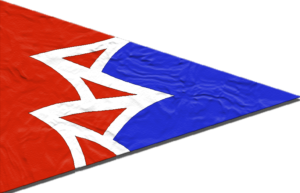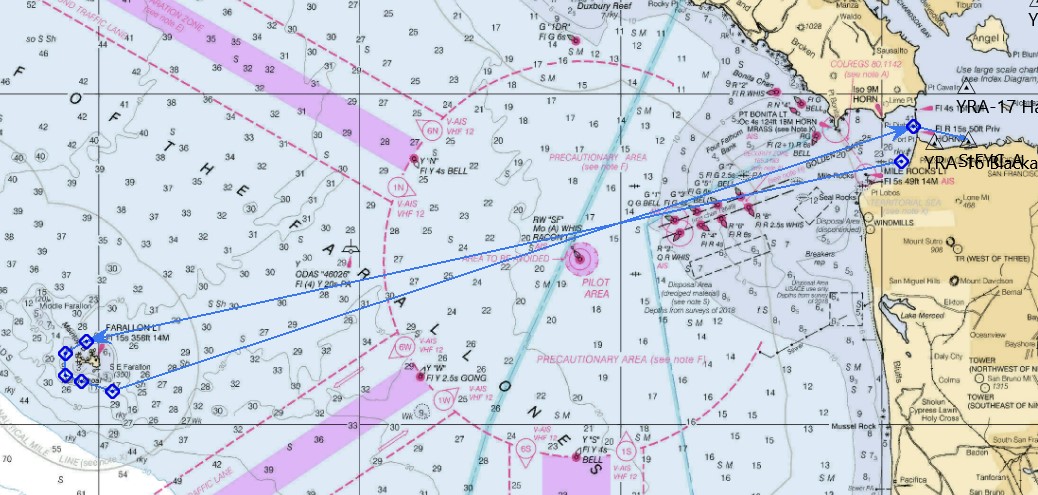The Fun - The Challenge - The Experience
SF BAMA’s Doublehanded Farallones Race begins in the shadow of the iconic Golden Gate Bridge and takes competitors over the San Francisco Bar to Southeast Farallon Island and back. It is the ideal short-handed offshore sailing event. The original ULDB and legendary Merlin won the event in the early years and boats as big as Santa Cruz 70s and as fast as Prosail 40s and Antrim 40 trimarans have set course records, while one design fleets such as the Moore 24, F-27, Express 27s and 37s, and various classes of J/boats often sign up en masse.
Southeast Farallon Island and its mates are, in essence, a line of granite rocks carved away from the California coast by the infamous San Andreas fault 26 miles West of the Golden Gate. On a clear day the islands appear oh so close, but it feels a long way if the Gulf has dished up sporty conditions.
Yes, the Doublehanded Farallones is tough event, but it’s the very nature of this race that has made the great sailors great. Yes, you will need safety gear, and yes, you will need to have your act together. This course demands good seamanship, not just in super-windy conditions, but in the light years too.
Yet this is one incredible body of water. One may see whales or sight the occasional sunfish and there are lots of bird species in the area. On calmer days fur seals and sea lions can easily be heard barking as you round the Islands. Oh, and Great White sharks migrate here to snack on those aforementioned seals too!
Sailors come back year after year because the Gulf of the Farallones can be a wonderful playground too. Both Monohull and Multihull course records were set in reaching conditions of a 15-knot southerly breeze! It's pretty rare, but it does happen. Our more typical wind direction is from the Northwest and can blow anywhere from light winds to mid-30’s. While most multihulls finish before dinner, don’t worry, we’ll be there for you all the way to the midnight cutoff if you need a bit more time.
The DHF provides stellar racing. The tactical decisions you make right off the start do make a difference, and the drag race out to the islands gives you the opportunity to find new gears you didn’t know you or your boat had. Once out there, rounding the SE Farallon can be tense, but once safely around, the fast reach home reminds crews why they do this race: It’s really fun!
The Course
The Course has racers start between the Golden Gate Yacht Club and the X buoy, sail in either direction around the islands, keeping 1,000 feet from the islands at a minimum, and finish back at the X buoy by the Golden Gate Yacht Club.
The Islands
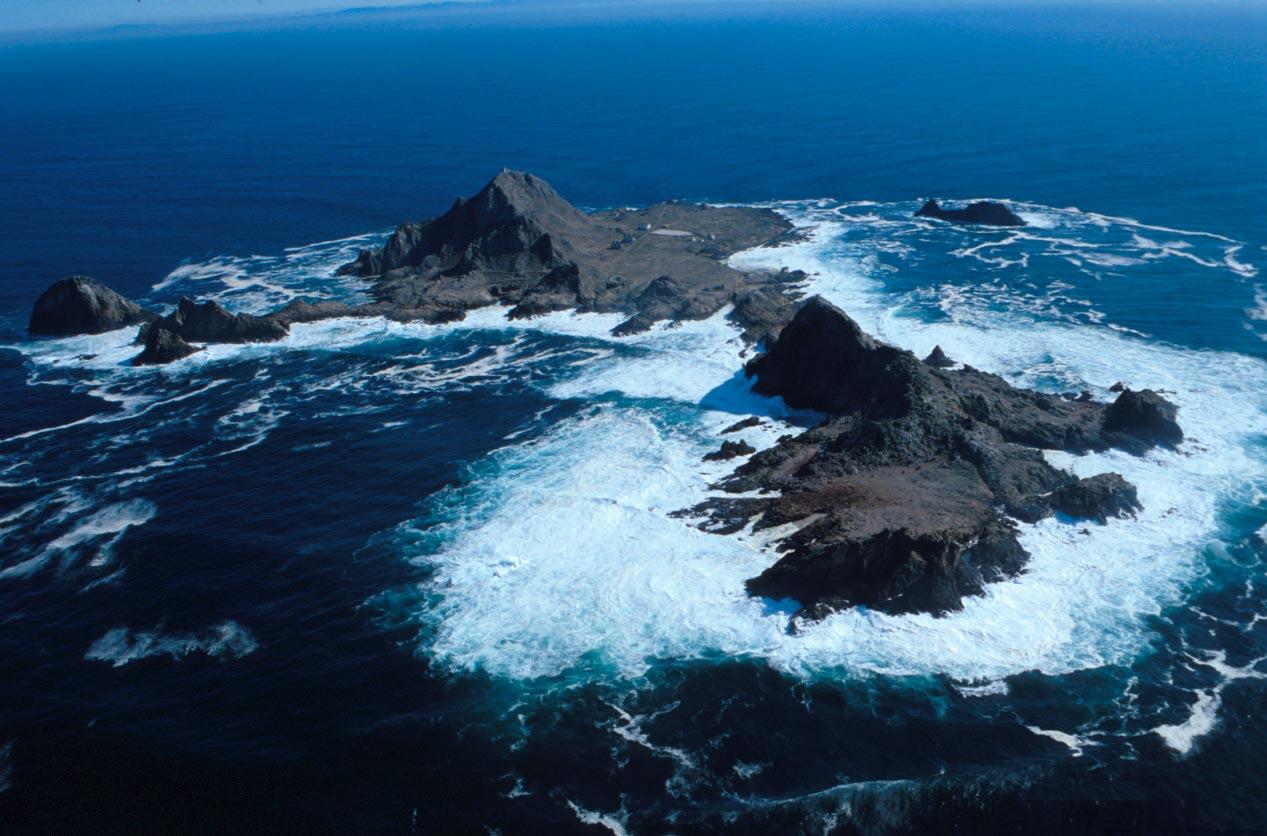
photo: Jan Roletto
The Farallon Islands, sometimes referred to as the Devil’s Teeth Islands, are actually part of the city of San Francisco, but while the hilly topography could be familiar, almost nothing else is. The Farallon Islands are located approximately 24 NM offshore, and are the last bits of land heading west until mariners reach Hawaii. Waves batter the islands as Pacific Ocean swells rise up in the shallow waters surrounding the islands. The islands have no landing spot for boats.
The islands are a National Marine Sanctuary, with lots of seals and bird life. There is a lighthouse and a research station on Southeast Farallon Island, where a few intrepid researchers spend a few weeks at a time studying the local birds and wildlife.
Conditions vary wildly at the islands. They are sometimes shrouded in thick fog, where mariners rounding the islands will only see glimpses of the rocky outcroppings. Sometimes conditions are gentle. During eddy conditions offshore, you might see 10 knots of breeze from the southeast instead of the prevailing northwesterly. The islands definitely see their fair share of rough conditions. Strong winds from the northwest in the mid-20s or higher during the summer are typical, as are strong storm winds from the south during the winter. And that forbidding shoreline gets pounded by swells when conditions are rough or when there’s been a big storm in the Pacific.
The rounding of the islands can be intimidating when conditions are rough. There are several shoal areas around the islands, and when the swell is up there can be large breakers. Also, big waves refract off the island causing confused seas, throwing around rounding boats, adding to the intimidation factor.
Safety in Focus
The Gulf of the Farallones is a serious venue, with sometimes seriously rough conditions, and it’s important for boats and crew to be well-prepared to tackle the conditions and events that can occur. The Doublehanded Farallones Race has seen its fair share of fatal and near fatal incidents through its history. Unfortunately, that includes four lives lost in a big storm in the 1982 race, one life lost in 1984 after a boat broke apart on the way back from the islands, and one life lost in 1999 after both crew members on a boat were washed overboard. There have also been several dramatic rescues, often by fellow racers, after serious incidents (capsizes, pitch-poles, big waves, and crew overboard events). And there have been several cases of serious equipment failures, including multiple incidents of lost steering and one lost keel. Southeast Farallon Island was also tragically the site of the Low Speed Chase Incident in the 2012 OYRA Full Crew Farallones Race, where five lives were lost in the surf.
In the interest of safety, the 2024 Offshore Safety Equipment Requirements are in effect. Additional safety requirements are also listed in the NOR and Sailing Instructions.
Note that BAMA offers alternative solutions to allow certain boats to participate (e.g. for monohulls without lifelines, or for lifelines not meeting OYRA requirements, or to solve other issues for certain trailerable boats). Important: For the 2024 season, AIS transponders are now required for offshore races, but for the 2024 Doublehanded Farallones Race, we will allow any Jibeset-supported tracker, including the cellphone based Traccar app, for boats that have not yet installed AIS transponders.
BAMA carefully monitors the fleet during the race, and has radio check-in procedures for all boats left on the course after dark (except those that have AIS transponders where we can see their forward progress.) We also have a partnership with the San Francisco Ham Radio Club to ensure extended VHF radio coverage for the race track.
BAMA also offers regular training events on how to handle adverse situations, including live crew overboard training, and training on emergency steering.
Shoal Areas on the Race Course
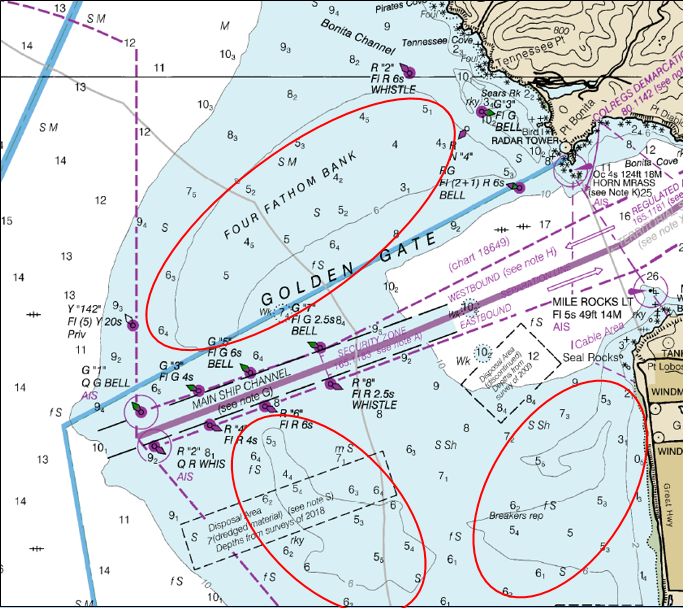
Shoal Areas including Four Fathom Bank, Ocean Beach, and the South Bar in red
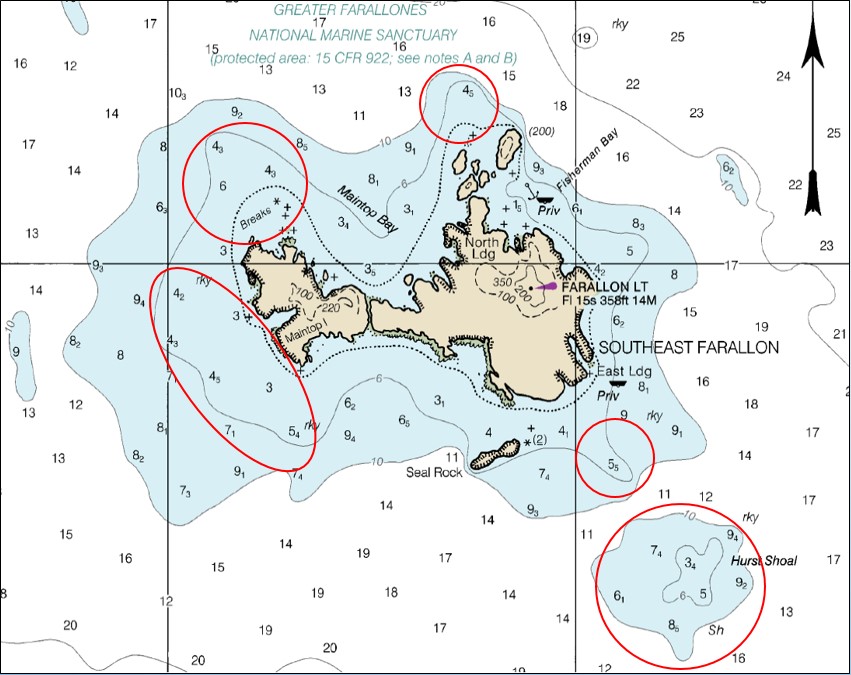
Shoal Areas near the Southeast Farallon Island in red
There are several shoal areas on the race course that need to be taken very seriously any time the swell is up. That includes several areas around Southeast Farallon Island, and areas closer to shore, including the Four Fathom Bank, the South Bar, and the area outside Ocean Beach. It is very important to monitor your depth while rounding the islands, and also while exiting from and returning to the bay, to make sure that you are in deep enough water for the conditions. Also note that because of the marine sanctuary, there is a 1,000 ft minimum standoff from any island or rock at the Farallones, and that includes Seal Rock on the south side of Southeast Farallon Island.
The Low Speed Chase incident in the 2012 OYRA Full Crew Farallones Race, where five sailors drowned, happened as a result of rounding the island too closely, in water that was too shallow for the wave conditions.
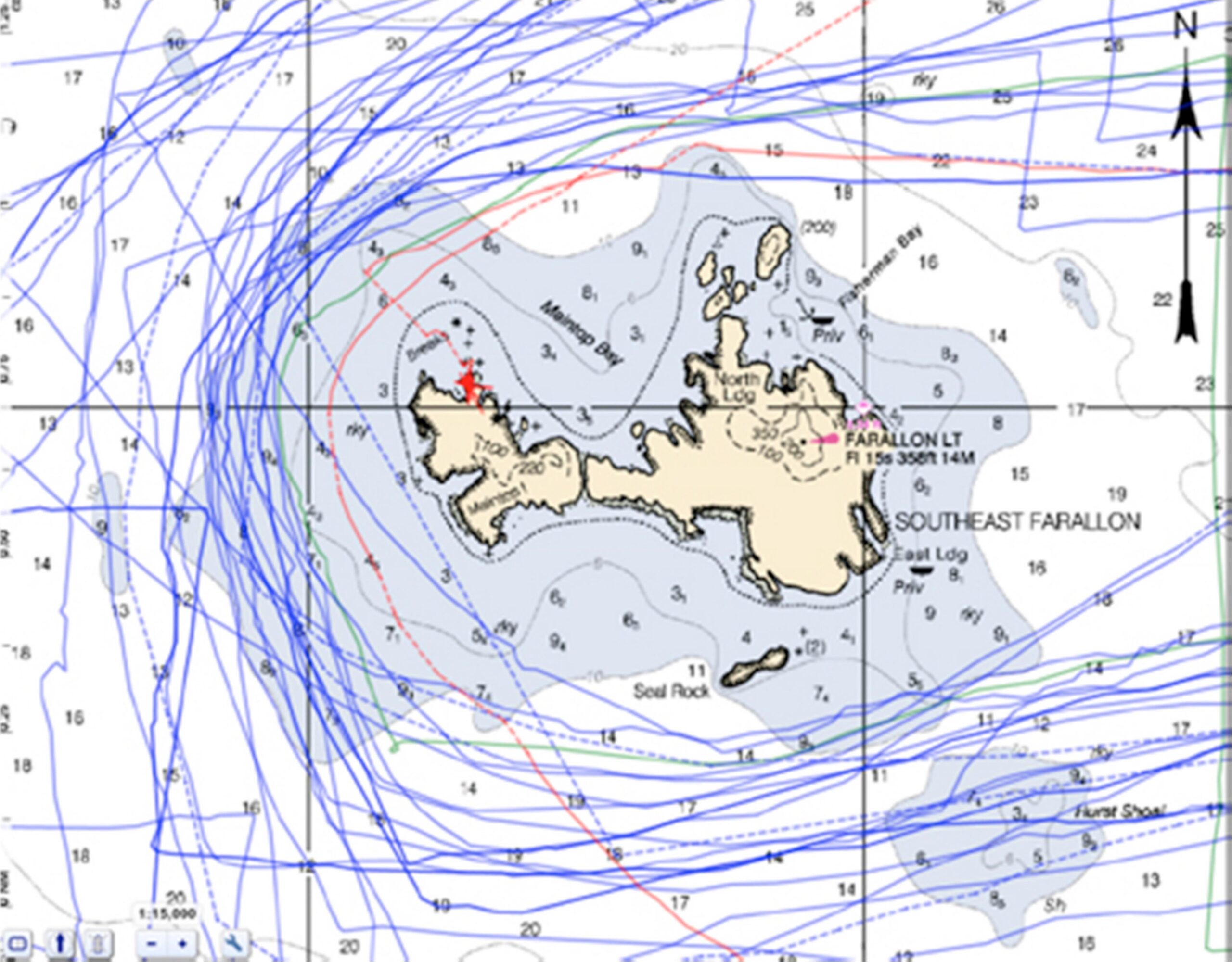
The fatal course, which abruptly turns at a right angle where the boat was rolled by a rogue wave, is shown above in red. All crew members except one were swept overboard, and the boat was ultimately washed up on Maintop Island.
The second red course shown, even closer to the island, was recorded by the same boat, Low Speed Chase, the year before.
Perpetual Trophies
- Stewart Kett Memorial Trophy First monohull on elapsed time
- 2023 winner: Timber Wolf (Farr 38), David Hodges & Tim Cordrey: 08:15:26
- Harvey Shlasky Perpetual Trophy for the boat with the lowest corrected time
- 2023 winner: Bottle Rocket (Seacart 30 GP+), David Schumann & Trevor Baylis: 07:15:59
- First Multihull on Elapsed Time
- 2023 winner: Bottle Rocket (Seacart 30 GP+), David Schumann & Trevor Baylis: 05:334:42
- Randy Devol Memorial Trophy for first multihull on corrected time
- 2023 winner: Bottle Rocket (Seacart 30 GP+), David Schumann & Trevor Baylis: 07:15:59
- Dennis Madigan Perpetual Trophy for crew member of the first boat with the lowest elapsed time (either monohull or multihull)
- 2023 winner: Trevor Bayliss, Bottle Rocket (Seacart 30 GP+)
- Pineapple Sails Yacht Club Trophy for club with top 3 placing entrants
- 2023 winner: Richmond Yacht Club (Topper II, Oxymoron & Timber Wolf)
Other overall awards
- First Mixed Gender Boat on Corrected Time
- 2023 winner: Puffin (Moore 24), Patrick Haesloop & Kelly Gregor
- First All-Female Crewed Boat on corrected time
- 2020 winner: Envolée (Beneteau Figaro), Nathalie Criou & Hannah Droesbeke (there were no all-female crews in the 2021 through the 2023 editions of the race)
Some Interesting Race Facts
The 4-hour Barrier for Elapsed Time for Multihulls:
Very fast multihulls have participated in the Doublehanded Farallones Race over the years, and they have posted some of the fastest elapsed times in the race. In the very first DHF in 1980, it took the fastest multihull just over 20 hours(!) to complete the course, but much faster times have been recorded since then. And when the conditions are right, multihulls can really fly on this course, and have posted some staggeringly fast elapsed times. Case in point: the record-breaking 1992 race, when two multihulls finished in less than four hours (the Antrim 40 trimaran Aotea, and the ProSail 40 TomCat – which is still the course record holder). Aotea recorded two other finishes under 5 hours, and one under six hours, and two other multihulls have been under six hours (the Antrim 30+ trimaran Erin, in 1999 and 2005, and the 48-ft catamaran Wind Warrior, in 1987).
The 6-hour Barrier for Elapsed Time for Monohulls:
It’s tough to do for doublehanded monohulls, but the 6-hour barrier has been broken by monohulls just twice: Once by the Santa Cruz 70 Mongoose, in 1992, and once by the Owen Clarke Open 50 Truth, in 2012. Several other monohulls have gotten close, but getting under 6 hours requires the combination of a fast boat and the right conditions for going fast!
The 7-hour Barrier for Corrected Time:
Similar to the 6-hour barrier for elapsed time, the 7-hour mark has proven to be an almost unbreakable barrier for corrected time. Since 1998, only one boat had managed to do it. However, in the 2022 race, which had fantastic conditions, three multihulls managed to squeak just below: Papillon, Entourage and Greyhound, finishing with corrected times within just a few minutes of each other. For monohulls, in 2011, the Moore 24 Nevermoore missed out by just 57 seconds, correcting out at 7:00:57. Quite a few boats, both multihulls and monohulls, have finished with corrected times between 7 and 8 hours, but cracking through the 7-hour barrier is very hard to do!
However, when the conditions are just right, much faster corrected times are possible. In the record-breaking 1992 race (all DHF records for both elapsed and corrected time are from the 1992 race), both the multihull and monohull winners posted corrected times near the 4 ½ hour mark (see records below)!
The Most-Winning Boat Type on Corrected Time:
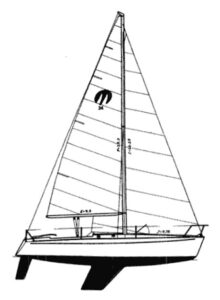
The Moore 24! The most-winning boat type on corrected time in the Doublehanded Farallones Race is the Moore 24, having won for monohulls overall 23 times! The Moore 24 was America’s first production line Ultra-Light Displacement Boat (ULDB), and the boat still holds its own today. With one of the largest racing fleets in the San Francisco Bay Area, the Moore 24 has a proud history in the DHF, with by far the most wins. There were only three Moore 24s that participated in the 2023 race. All three finished. The 2023 Moore 24 winner (and overall Monohull winner): Topper II, Conrad Holbrook & Kim Dincel.
Standing Race Records
Multihull Elapsed Time: TomCat (1992) Zan Drejes / Jack Halterman; ProSail 40 Catamaran; Elapsed Time: 03:30:44.
We believe this is the fastest time ever recorded in any Farallones race (including full crew races). The two other closest times that we know of: Aotea, in the same 1992 DHF race, finishing in 3 hours 48 minutes, and the Mod 70 Orion, finishing in 03:42:21 in the Full Crew Farallones Race in 2016.
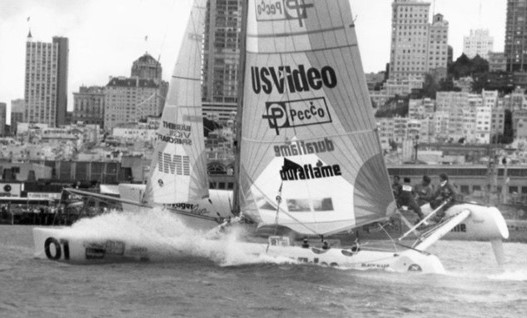
Prosail 40 Tomcat
Multihull Corrected Time: Sundowner (1992) Joe Therriault / W. Kipp; Buccaneer 33 trimaran; Corrected Time: 4:24:08
Monohull Elapsed Time: Mongoose (1992) Paul Simonsen / Stan Honey; Santa Cruz 70; Elapsed Time: 05:39:47
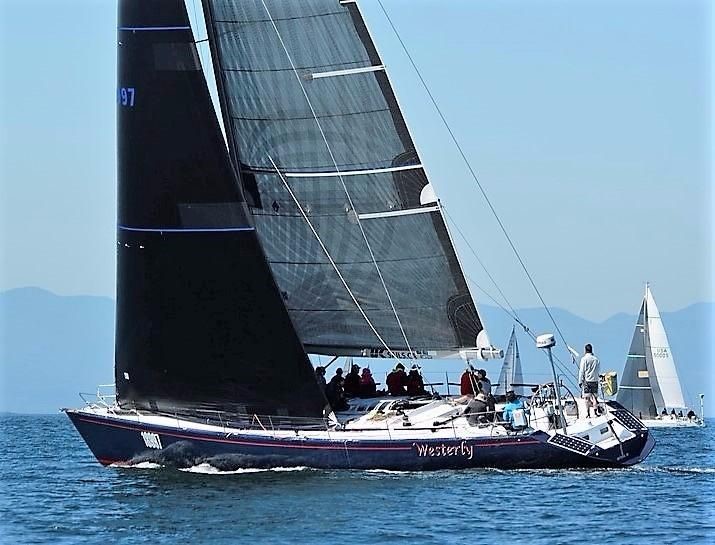
Santa Cruz 70 Westerly (ex-Mongoose)
Monohull Corrected Time: Valkyrie (1992) S. Kingsley, P. Kamen; Formosa 41; Corrected Time: 04:34:16
Racer Profiles
David Hodges and Scott Walecka: The most-winning pair through the history of the Doublehanded Farallones Race is David Hodges and Scott Walecka, who won the monohull class overall on corrected time in the Moore 24 Adios on 9 of 10 tries in races between 1987 and 1999, missing out only once, in 1996, when they raced the Moore 24 Fatuity instead, and finished 4th. David Hodges also won for monohulls overall on corrected time in 2007, 2010 and 2021 with his Farr 38 Timberwolf, and was the fastest monohull on elapsed time in the 2023 race.
Peter Hogg: Former DHF Race Chair Peter Hogg posted a remarkable set of results in various multihulls between 1987 and 1994, and posted the fastest elapsed time a total of seven times, five of them as skipper – twice in the 40-ft catamaran Tainui, and three times in Aotea, his Antrim 40 trimaran, and twice as crew – on the 48-ft catamaran Wind Warrior, and on the 30-ft trimaran Erin. With Aotea, he posted the second-fastest elapsed time in the race ever in 1992, finishing in 3 hours 48 minutes.
Just days after that race, Peter sailed Aotea from San Francisco to Tokyo, and posted the record that still stands for that distance, recognized by the Guinness Book of World Records, finishing in just 34 days, 6 hours, 26 minutes.
Unfortunately, Aotea was lost in the 1995 Doublehanded Farallones Race after pitch-poling on the way back to the bay. The boat eventually drifted upside down to Micronesia.
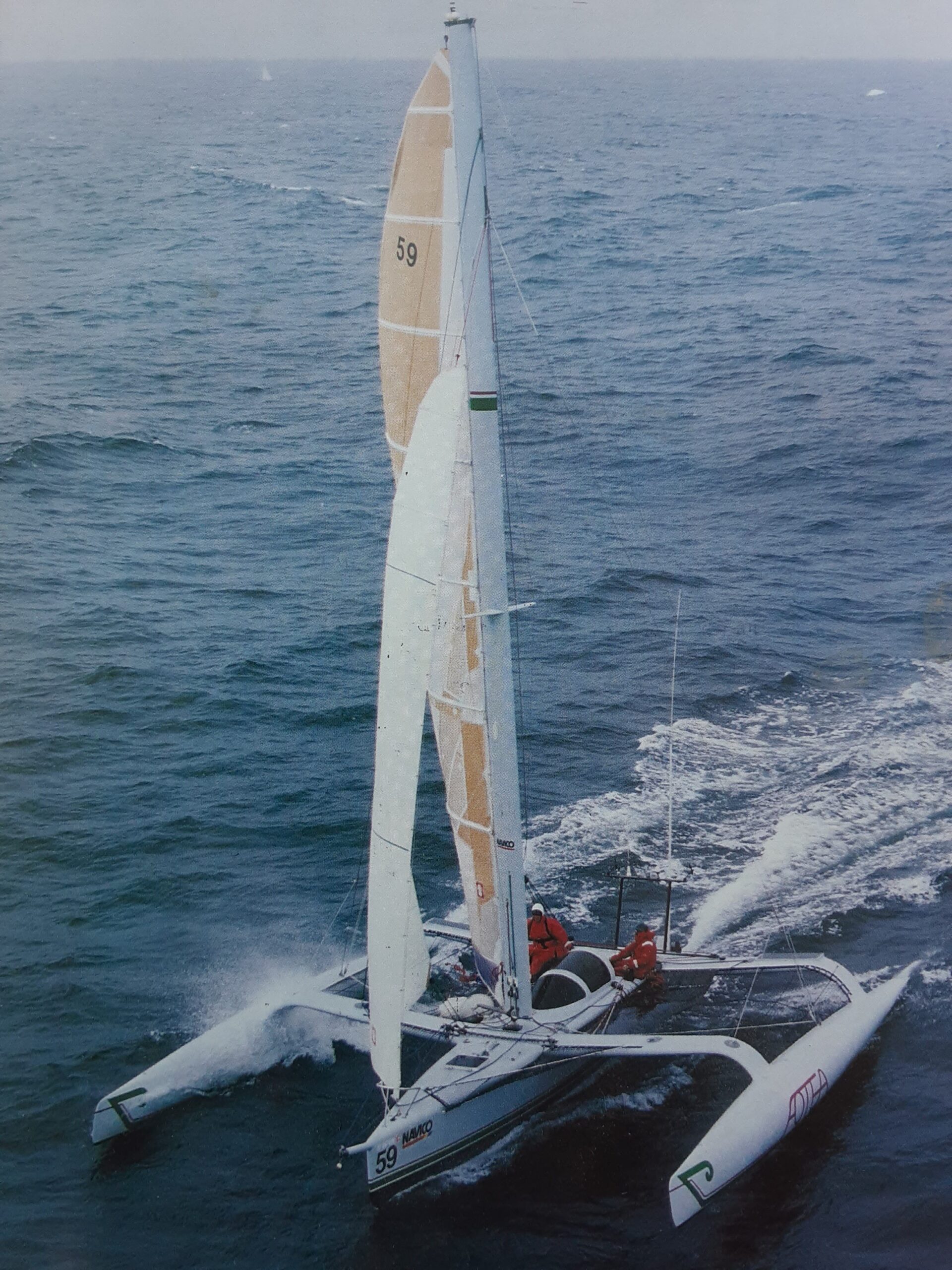
The Antrim 40 trimaran Aotea in either the 1991 or 1992 DHF race.Joe Therriault: Former BAMA Commodore and former DHF Race Chair Joe Therriault posted strong results in DHF races between 1980 and 1992 with this Buccaneer 33 trimaran Sundowner. He posted the fastest elapsed time four times (1980, 1984, 1989 and 1990), and he still holds the multihull corrected time record from 1992.
Hill “Buzz” Blackett: In the last decade, Buzz Blackett has posted the most wins for monohulls, posting the fastest elapsed monohull time six times with his Antrim Class 40 California Condor, and winning for monohulls overall on corrected time in 2020 with his Antrim-27 monohull Io. Most recently, Buzz posted the best elapsed and corrected time for the ULDB class in the 2021 race with Io.
Jim Antrim: Naval architect Jim Antrim has a special history with the Doublehanded Farallones Race. He has designed several of the multihull and monohull winners over the years, including the 40-ft trimaran Aotea, the 30-ft trimaran Erin, the Class 40 monohull California Condor, and the 27-ft monohull Io. In addition, he has crewed in the race on many of these same boats, posting the fastest elapsed time for multihulls five times (three times on Aotea, twice on Erin), and the fastest elapsed time for monohulls four times on California Condor. Jim most recently posted the best elapsed and corrected time in the ULDB class in the 2021 race as crew on the Antrim-27 Io.
2024 Race Updates
For 2024, the race is returning to its traditional early-season April date. Th e2024 race date will be Saturday, April 13, 2024.
- BAMA will continue its partnership with the San Francisco Ham Radio Club to provide improved VHF communication. Gone are the days with radio silence as the race committee relay station now beams live from near Land’s End with high power antennas and radio equipment.
- We are moving the start back to the Golden Gate Yacht Club. That means a shorter path to get to the start in the morning!
- Racers will again have the option of sailing inside Mile Rock to avoid current, and will again have the option to round the Southeast Farallon Island in either direction for improved tactical choices. Most of the winners from the 2022 race tacked around, leaving the island to starboard.
- The standard YRA safety equipment requirements will apply, but BAMA will continue to offer its alternate solutions to allow additional boat classes to participate (e.g. Moore 24 and Express 27 fleets, various trailerable boats). Note that for the 2024 season, AIS transponders are now required for offshore races, but for the 2024 race, BAMA will accept any Jibeset-supported tracker, including the cellphone-based Traccar app. BAMA remains committed to helping racers find solutions to meet safety requirements. Our goal is to facilitate participation from as many boats as possible.
- Our pre-race briefing includes topics like safety, weather and conditions expected, plus how to stay safe in the shipping lanes and avoid ship traffic.
- Live scoring via Jibeset! As soon as anything happens on the course, we post it, throughout the day, starting as soon as all fleets have started!
- Live position reports for boats with trackers, including automatic position updates for boats with AIS transponders, relayed to shore via select boats equipped with AIS position relay units.
Coming From Outside the Bay Area?
Every year, we have participants in the Doublehanded Farallones Race from outside the Bay Area, including registrants from Southern California, Oregon, Washington, Nevada, and often from places further afield. To simplify participation for crews traveling from out of town, we've taken the following steps:
- Both the skippers meeting and the awards meeting are virtual, conducted over Zoom, and the meetings are recorded and posted for anytime replay
- We ship the commemorative souvenir items directly to your home. You don't need to show up in person anywhere to pick them up. We will make suitable arrangements for awards if you win your class or a perpetual trophy
- If you are trailering your boat to the area, please review our guide to Launch Ramps in the San Francisco Bay Area
The anchorages closest to the start and finish line are:
- Aquatic Park, on the San Francisco cityfront: https://www.nps.gov/safr/planyourvisit/aquaticparkcove.htm (reservation required for overnight anchoring)
- Richardson Bay, between Sausalito and Belvedere, across the bay from the finish
- Ayala Cove on Angel Island: https://angelisland.org/visitor-information/boating-camping/ (beautiful and very well-protected anchorage with moorings up to 50 ft)
- Clipper Cove on Treasure Island (large and well-protected anchorage on the leeward side of Treasure Island)
Another anchorage option, outside the Golden Gate, close to the start, is Bonita Cove, just inside Point Bonita, which offers good protection during northwesterly winds (but is much less protected in winds from the south).
There are also many yacht clubs and marinas around the bay that may be able to offer guest slips. The ones in San Francisco, Sausalito or Tiburon are going to be closest to the start and finish, but there are many yacht clubs and marinas in Alameda, Emeryville, Berkeley, and Richmond that are also within fairly easy reach of the start and finish.
